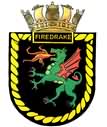 |
|
HMS
Royal Arthur
Class 110 Skegness 1940 |
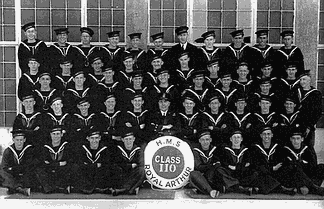 |
| HMS
Royal Arthur. Was one of several assessment camps where new recruits
would be assessed, kited out and sent to there various depots there
were thousands that went through these camps. Before the war HMS Royal Arthur had been a Butlins holiday camp and after the war was reverted back to just that, I myself stayed there in the early 60s. The photo above was given to me by Able Seaman Bill Aldous who served on the Firedrake from mid 1940 to late 1942. In the photo their are five of the Firedrake’s crew: Back Row Standing Extreme Right is: Ab Smn Bill Aldous. Middle Row Standing Left to Right No.10 is: AB Smn Gooding. First Row Standing Left to Right No.2 is: AB Smn Bert How. Sitting-down Left to Right No.7 is: AB Smn Wiggy Bennett. Sitting Cross-legged Left to Right No. 5 is: AB Smn Leonard Browne. |
 |
 |
 |
|
|
|
AB
Smn Bill Aldous
|
AB
Smn Gooding
|
AB
Smn Bert How
|
AB
Smn Wiggy Bennett
|
AB
Smn Len Browne
|
| Only one of these five was lost with the Firedrake Able Seaman Leonard Browne who came from the Waterside in Londonderry Northern Ireland. |
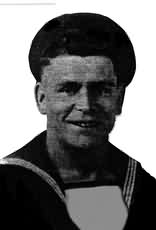 |
HMS
Glendower. Was another recruitment assessment camp, that camp was in North Wales at another Butlins holiday camp at Pwllheli, this is where Arthur Snelling and Billy Kay were told to attend, the photo on the right was taken at HMS Glendower by Arthur Selling so is not in the picture, but standing on the extreme right is Billy Kay sadly both were lost with the Firedrake when she was sunk in 1942, |
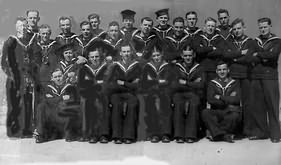 |
|
Douglas
James Conway ( Dick)
HMS Firedrake 1938-1941 |
|
| I joined the
R.N. for 12 years on 2.2.37. I had reached the age of 18 on 4.12.1936.
My home station was Chatham. On joining I was given the exalted rank
of 2nd class stoker with the pay of two shillings and sixpence (12˝
new pence) a day. In addition to this vast sum I was also given one
shilling and sixpence a week clothing allowance. After the first issue
of clothing you were expected to buy your own not only expected to
but were compelled to. Provided one was reasonably efficient one was
promoted after one years service to 1st class stoker and awarded an
extra one shilling a day (5p) thus jumping in one bound from 19 shillings
(95 new pence) a week to 26 shillings (Ł1.30). I joined HMS Sussex, a county class cruiser on 29.6.1937, she was part of the Mediterranean fleet, while serving aboard her I was awarded the Palestine medal. I left the Sussex on 8.5.1938 and returned to the UK. I was then posted to HMS Firedrake on 3.9.1938. She was affectionately known as (The Old Fish-cake). I was at first employed in the boiler room watch keeping. After promotion to the heady height’s of leading stoker on 17.11.1940, I was then employed in the engine room at sea and in harbour. |
 Photo above. A-Gun with from left to right: O’Leary, Conway, Bruce, Cheney and Eason. |
War
was declared on Sunday 3.9.1939, we were at anchor in Scapa Flow but
put to sea and were dropping depth charges the same afternoon. We
were also at anchor in Scapa Flow when the battle ship Royal Oak was
sunk at anchor with heavy loss of life, a U-boat was suspected and
blamed but I had always thought that sabotage was the more likely
course of her destruction. I could see how a U-boat could get into the anchorage at Scapa Flow but not how it could get out again, after alerting a large number of destroyers with Asdic submarine detectors onboard who would have been in close vicinity. I believe a U-boat captain named Preen did claim he had sunk the Royal Oak, but he did not survive the war so his claim could not be further verified or checked at first hand. |
| I
can distinctly remember the sinking of U-39 and the picking up of
survivors from her, these survivors were distributed among the other
two destroyers who had taken part in the action. We had one of these survivors allocated to the stokers mess, after sixty odd years my memory is not all that it should be but I think his name was possibly Horst Zigfurt, he claimed to be a torpedoman and was convinced that the U-39 had sunk the aircraft carrier Ark Royal whose escort we were, we took him top side and showed him the Ark Royal sailing along completely undamaged. He then said that even if U-39 had not sunk the Ark Royal she had at least sunk the destroyer with H79 painted on her side, any friendly feeling I had for him completely evaporated at that moment H79 was the Firedrake’s pennant number. |
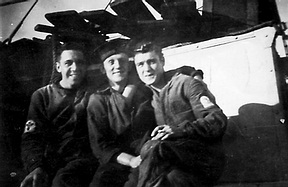 Photo above left to right: Eddie Smith , Fishy Place and Dick Conway, Smith and Place were lost with the ship in 1942. |
| During my service on the Firedrake I can distinctly remember the following incident I think it was 1940 when it happened we were at anchor in the Clyde near Greenock when a torpedo was accidentally fired along the deck and into the fo’c’sle of a French destroyer about ˝ a mile from us, it destroyed the for part and upper-deck trapping everyone forward between decks, they were unable to escape through the portholes because they were too small. Those trapped all perished either by fire or by drowning when she sank. I can faintly remember the name of that French destroyer, I think it was the Maillé Brézé there was of course quite a lot of French sailors who survived. |
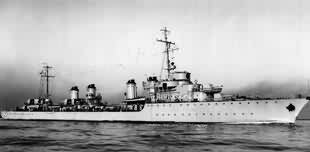 |
The
positive thing that came out of this horrible event was that on all
mess decks at least one port hole was enlarged to make escape possible. The Firedrake was at Narvik in Norway during the Norwegian campaign, the thing I mostly recall is that it stayed light 24 hours a day, and that there was always or it seemed as if there was always German bombers overhead, the main reason we escaped from Narvik relatively unharmed was down to the skill of our captain Lt Commander Steven Norris. Photo left the French destroyer Maillé Brézé. |
| I left HMS
Firedrake on the 26.6.41, after serving over 2˝ years aboard her she
had during the last year or so of my time on her been in the Mediterranean
with force H under the command of Admiral Sir James Somerville. I left the Royal Navy on the 13th April 1949, as a Petty Officer, after 12 years, in my time from leaving the Firedrake and leaving the Royal Navy I served on many other ships here are just a few of them. |
| Battleship | HMS | Resolution | Sloop | HMS | Sheldrake |
| Destroyer | HMS | Vigilant | Depot ship | HMS | Wayland |
| Aircraft carrier | HMS | Vengeance | Supply ship | HMS | Bulawayo |
|
Petty
Officer Robert Pickersgill
by Mike Pickersgill |
|
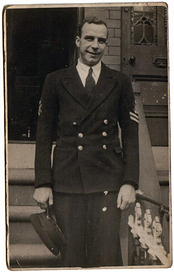 |
My
knowledge of my father is limited to information passed on to me by
relatives who knew him. He was brought up in Jarrow, North East England,
which was at that time an area of considerable hardship and high levels
of unemployment. Apparently, he was a very bright lad at school and succeeded in passing an examination which gained him entry to the local Grammar School something which was not common amongst his particular peer group. It was here that he came into contact with a Royal Navy Officer, who had come to his school to give the boys a Careers Talk. The combination of financial hardships at home and the attractive picture painted of life in the Royal Navy persuaded my dad to join up, something which necessitated telling white lies about both having parental approval, and being old enough! He signed on for 12 years and then returned home, where he managed to persuade his parents to accept this. He then went all over the World, spending a considerable time on duty in various parts of Far East, which he found to be a fascinating place, often going also to Malta and Gibraltar, both places he liked very much, and visiting the United States on several occasions. |
| During
this time, he served on a number of different ships, amongst which
were HMS Eagle and HMS Rowena. He had been told by a family friend
about an attractive young woman living in Leeds who was an excellent
pianist, and deciding he wanted to see this young woman, Hilda Howitt,
he accompanied this friend to Leeds. It was quite literally love at first sight for both my mother and father, and they were married on Christmas Day 1937. Following their marriage, they went to live in married quarters in Chatham Barracks, my mother moving back up to stay with her parents in Leeds in 1941 as my father felt she would be safer there. I was born in May that year, and later my mother was expecting a second baby due to be born towards the end of 1942. In October '42, my mother received a telegram from dad in which he said he hoped to be home soon. She later received a second telegram from him dated 4 Dec. '42, in which he stated that there was 'no leave yet', but that he was expecting to be home for the birth of their second child, my sister Barbara. |
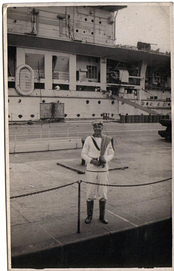 |
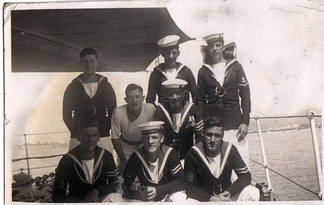 |
That
was the last my mother heard from him, because the next telegram she
received, dated 23 Dec. '42, was from the Commodore of RN Barracks,
Chatham, telling her that my father was 'missing, presumed killed'. My sister was born on 31 Dec. '42. Not surprisingly, Christmas time was a very sad occasion for my mother for many years after the death of my father, something she never got over, which is why she never remarried. I hope these remarks are helpful, I'm attaching three photographs of my father one taken when he was on leave in Leeds, one in front of HMS Eagle and another one of him with his mates on the bow of a destroyer when on the China Station Wei-Hai-Wei. |
| Many thanks to Mike Pickersgill for this article. |
|
|
|
Petty
Officer Thomas George Noble.
|
|
| Petty
Officer Thomas George Noble. Tommy to his mates was lost with one hundred and sixty seven of his mates when the Firedrake was sunk on 17th December 1942. Tommy was born in Mile End in the east end of London on the 17th January 1917. His family moved to Dagenham in Essex when he was quite young. Tommy joined the navy as a boy seaman at the age of 15 on the 6th September 1932 and went to HMS Ganges the training Centre at shortley to do his initial training. He joined the cruiser HMS Suffolk on the 3rd August 1933 on which he served until 30th August 1935, during which time he was promoted from boy seaman to ordinary seaman. He was then drafted to Chatham barracks for a short time then joined HMS Vanquished on the 12th October 1935 to 2nd June 1936. |
|
| Promoted to Able seaman saw him moving again to Chatham where he remained until he joined the cruiser HMS Southampton on 11th March 1937, serving in her until he was once again drafted to Chatham on 13th January 1939 for anther short spell. Tommy joined the Firedrake on the 28th April 1939 gaining promotion to Leading seaman on 13th June 1940 and then Petty Officer on 14th September 1941. |
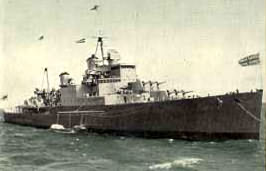 HMS Southampton. |
It
is thought that he served on 'A' Gun as the gun layer, on his last
leave he informed his wife and parents that he was leaving the Firedrake
but because of shortages he would have to remain aboard for one more
voyage and alas this was her last. He left a father Thomas, who had also served in the navy, a mother Hanna, a sister Constance a wife Emily and a son Anthony aged three, nine days after his death his wife gave birth to a daughter Brenda. Anthony followed in his fathers footsteps, joining the navy at the age of 15 and serving as a regular from 1955 to 1966. Tommy's wife Emily sadly passed away in August 2003 at the age of 83. |
|
HMS
Firedrake Battle Honours
|
|
| BANTRY
BAY GOREE BELLE ISLE HELIGOLAND ATLANTIC NORWAY SPARTIVENTO MEDITERRANEAN MALTA CONVOYS |
1680 1758 1761 1914 1939-1942 1940 1940 1940-1941 1941 |
|
Displacement
- standard |
1,350
tons 329 ft 33 ft 3 ins 10 ft 10 ins 13 ft 11 ins 2 Shaft geared steam turbines 36,249 SHP 35.8 knots |
|
Guns Gun Guns Torpedo tubes Anti submarine weapons Anti submarine weapon Anti submarine weapons |
4 x 4.7 inch 1 x 3 in AA 2 x .5 in multiple machine guns 4 x 21 in 2 depth charge throwers 1 depth charge rail 38 depth charges |
|
Specifications
changed after refit in Boston USA 1941-2. The Aft
(Y) 4.7 inch Gun and the TSDS ( two speed destroyer sweep ) removed,
replaced by additional depth charge throwers and rails with stowage
for about 70 depth charges.
|